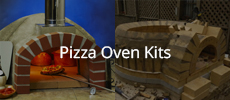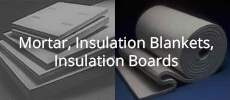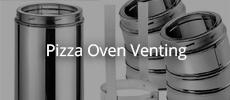Re: Getting Started
Someone on eBay is selling a decrepit franklin stove, might save you a mess of work:
Antique cast iron wood or coal burning stove not sure - eBay (item 230248084842 end time May-06-08 10:55:35 PDT)
a more current listing:
Franklin Woodburning Stove Fireplace. Huge! Excel! N/R! - eBay (item 120257584868 end time May-10-08 18:32:18 PDT)
X
-
Re: Getting Started
Having not even seen a sketch, I'm a little bit at sea here. From what I understand the fireplace chimney goes behind the oven, and there is a large horizontal smoke chamber behind the fireplace, which vents out the back of the top like a wood stove. Now, if this smoke chamber is what has the exposed wonderboard facing, this may be borderline OK. If the top of the actual firebox has plain masonry there, where flames will be licking up on it, I'd have to say you would want some firebrick up there, if only it's a row of splits substituting for the board at that point.
As for me, I'm not sold on this long horizontal smoke chamber, although I suppose Franklin stoves work with a length of stovepipe coming horizontally out the back. If it were me, I'd try to line it with flue tile. You can buy it in big 12" square sizes where one would make a ready made smoke chamber. The basic problem here is that outdoor fireplaces don't have the temperature differential from the top of the flue to the bottom that make indoor flues work. This is the reason why outdoor fireplaces sometimes smoke.
Leave a comment:
-
Re: Getting Started
I'm not sure if I understand your intentions with the backerboard. Is the fireplace's roof covered in firebrick, then backerboard on top of that, then your oven's concrete hearth?
The way you posted it, it sounds like you will have flames directly in contact with backerboard. I don't think that's going to work. They have some type of mesh in them that will certainly break down with intense heat (at least that's my guess).
Dmun?
Leave a comment:
-
Re: Getting Started
Quick update: Off-topic - Picked up a Big Green Egg last weekend. Got it home Saturday nite, set it up, lit a fire, and smoked a Boston Butt overnite. That thing held 225* for 16 hours, until I pulled the butt off. It turned out wonderful. If the rain stops, I'll be doing my pizza's on it tonite.
On-topic - I got my foundation completed. I leveled the top and filled the cells of the attached block and laid the first course of the back row. I should have the rest of the block work done for the fireplace this weekend.
Looking for a few thoughts on the following: Since I will have the fireplace below the oven, forming the concrete on the hearth is proving to be a challenge. I think I came up with an answer. I'm going to use backer board (cement board) us the base of the form. I figure it's has some insulating value, which should help protect the cement from direct flames, and I won't have to worry about removing it after the cement is poured, which is proving to be almost impossible.
I have pic's in my camera, I'll try to get them downloaded this weekend, if anyone is interested.
Leave a comment:
-
Re: Getting Started
Since you asked I started with a great deal on a Jenn-air NG grill 2 years ago. Got it for half price, as someone special ordered it and the Lowes mgr figured it would never sell. (Got it for $350
I started with a great deal on a Jenn-air NG grill 2 years ago. Got it for half price, as someone special ordered it and the Lowes mgr figured it would never sell. (Got it for $350 ) A buddy that vacations with me and my family, is heavy into smoking (meats & fish!). This sparked my curiosity, and I started researching & trying different grilling and smoking techniques. That lead me to the pizza's, which I make on the grill once a week in the nice weather, which lead me to this site and building a WFO. Also, my family and I spend most weekend nites on our flagstone patio in front of a fire, hence the fireplace. I'm also ready to pull the trigger on a Grill Dome for smoking duties, and picked up a portable Ultra Sear Grill for doing steaks, chicken & veggies. After my fireplace/WFO is complete, I have to start work on my outdoor kitchen on my upper deck outside my indoor kitchen. I have a very busy summer ahead of me. It sucks being OCD.
) A buddy that vacations with me and my family, is heavy into smoking (meats & fish!). This sparked my curiosity, and I started researching & trying different grilling and smoking techniques. That lead me to the pizza's, which I make on the grill once a week in the nice weather, which lead me to this site and building a WFO. Also, my family and I spend most weekend nites on our flagstone patio in front of a fire, hence the fireplace. I'm also ready to pull the trigger on a Grill Dome for smoking duties, and picked up a portable Ultra Sear Grill for doing steaks, chicken & veggies. After my fireplace/WFO is complete, I have to start work on my outdoor kitchen on my upper deck outside my indoor kitchen. I have a very busy summer ahead of me. It sucks being OCD. Once this is all done, I'm not sure what my wife is going to be cooking anymore?
Once this is all done, I'm not sure what my wife is going to be cooking anymore?
Leave a comment:
-
Re: Getting Started
Re: refractory mortar for the firebox. I believe that is what the intended purpose of heatstop mortars are for. My answer is yes.
Leave a comment:
-
Re: Getting Started
Peter - it's pretty funny that I was counting the bricks in your picture from the AAC thread this morning. I came up with about a 24" interior diameter? I planned on posting a q on that thread but you saved me the trouble. Looks good.
Leave a comment:
-
Re: Getting Started
Originally posted by 70chevelle View PostOk -
Question: Is 2" of FB board without vermiculite/concrete below enough for insulation? By the way, I plan on using brick (solid, but not firebrick) for my hearth, not concrete, if that matters.
Dimensions: 30" diameter, 13.5" dome height, 8.5" x 18" door opening.
Insulation: I will cover the dome with refractory mortar, then 2"-3" of FB blanket, then fill the balance with vermiculite. The brick enclosure should allow for an additional 1" on the sides and 3"+ inches on top. All in all I'll have 2" FB Board, firebrick on edge for the floor, and 3"-6" of FB Blanket & vermiclite on top of the firebrick and refractory mortar.
Within the confines of my dimensions and design, should I be able to cook some pizza's?
Hi
Your dimensions are similar to mine, but I've got 4" of AAC under the hearth, and then a further 3" of vermiculite concrete. Not sure if this is overkill, but I've always worked with the premise that you can never have too much insulation...!
I've gone for the dome on hearth approach, as there is less cutting of hearth bricks in curves, which has to be easier !
Nice to see someone else with a 'smaller' oven !
Cheers
Peter
Leave a comment:
-
Re: Getting Started
I still have time for the final decision of flat or on their sides. Tonite I should have the foundation completed and ready for layout of the firebox and brickwork. Once that's layed up, I'll have to make a decision. I had another question, as I tossed and turned all nite thinking about this. Should I be using refractory mortar for the firebox bricks?
Also, I plan on laying bricks for my hearth and was thinking I may want to use some FB Board on below (the ceiling of the fireplace) to protect those bricks/mortar from the heat of the fire. Would this be overkill?
Leave a comment:
-
Re: Getting Started
I would not change my flat floor. I have cooked 10 pizzas without issue or much additional wood. For my usual family bakes, once the dome is white, I simply push the fire to the back of the oven and that is fine for at least 5-6. We are talking large 16" pizzas here. If I am doing more I add a 3-4" dia log or two after pushing the fire back. I have never had to add any more than that.
Originally posted by 70chevelle View PostThe amount of information makes my head spin. I'll tell you what I've read on here and other forums. Thinner floor will heat quicker, but cool faster. Thicker floor will take longer to heat, but retain the heat longer. For pizza's, it seems that the floor temp is very important, especially at higher temps (800+) and you don't want your floor temp coming down as your cooking. So which one is more efficient? Would you use more fuel for the longer heat up, and then longer cool down, or more fuel to keep your temps where you want them while you're cooking? Anyone?
Leave a comment:
-
Re: Getting Started
I could add one thing. Commercial ovens are thicker, but not a lot thicker. If a residential pre-made oven is about 2 1/2-3", and a Pompeii Oven using half firebricks if 4"-4 1/2" thick, a professionally made commercial pizza oven is about 4"-5" in the dome and 4" on the floor.Originally posted by dmun View Post.... Commercial ovens have thicker floors (and thicker domes) but they use bigger fires, and they never fully cool down.
James
Leave a comment:
-
Re: Getting Started
As a historical note: Pompeii oven building arose from frustration with the massive Scott style barrel vault ovens. When I joined the forum in the summer of 2005, the style was to put the vermiculite layer under the support slab. This didn't heat up at all well. Then there was a brief period of putting a second layer of brick under the floor, or just a slug of concrete there, buried in the insulation. This was called the island hearth. At least this left the floor insulated, but it still too too long to heat up. Finally, the idea of extra mass under the floor was abandoned, and makers (myself included) just put a single layer of flat bricks directly on the insulation.
The way to keep the floor hot is to keep a fire with flame licking up the dome of the oven. The produces a lot of heat, and it recharges the floor between pizzas. Commercial ovens have thicker floors (and thicker domes) but they use bigger fires, and they never fully cool down.
Leave a comment:
-
Re: Getting Started
The amount of information makes my head spin. I'll tell you what I've read on here and other forums. Thinner floor will heat quicker, but cool faster. Thicker floor will take longer to heat, but retain the heat longer. For pizza's, it seems that the floor temp is very important, especially at higher temps (800+) and you don't want your floor temp coming down as your cooking. So which one is more efficient? Would you use more fuel for the longer heat up, and then longer cool down, or more fuel to keep your temps where you want them while you're cooking? Anyone?
Leave a comment:





Leave a comment: